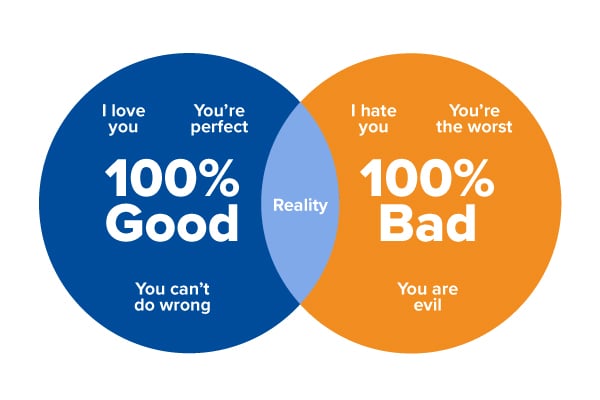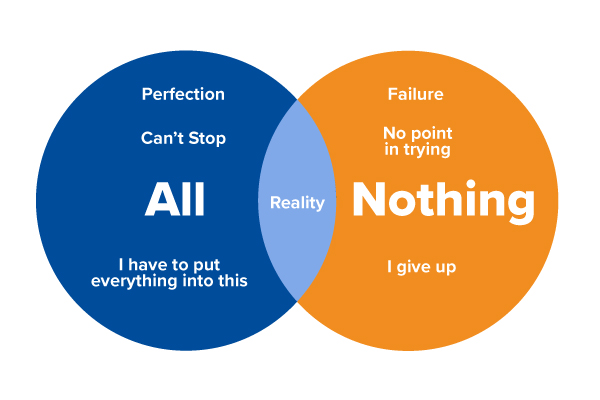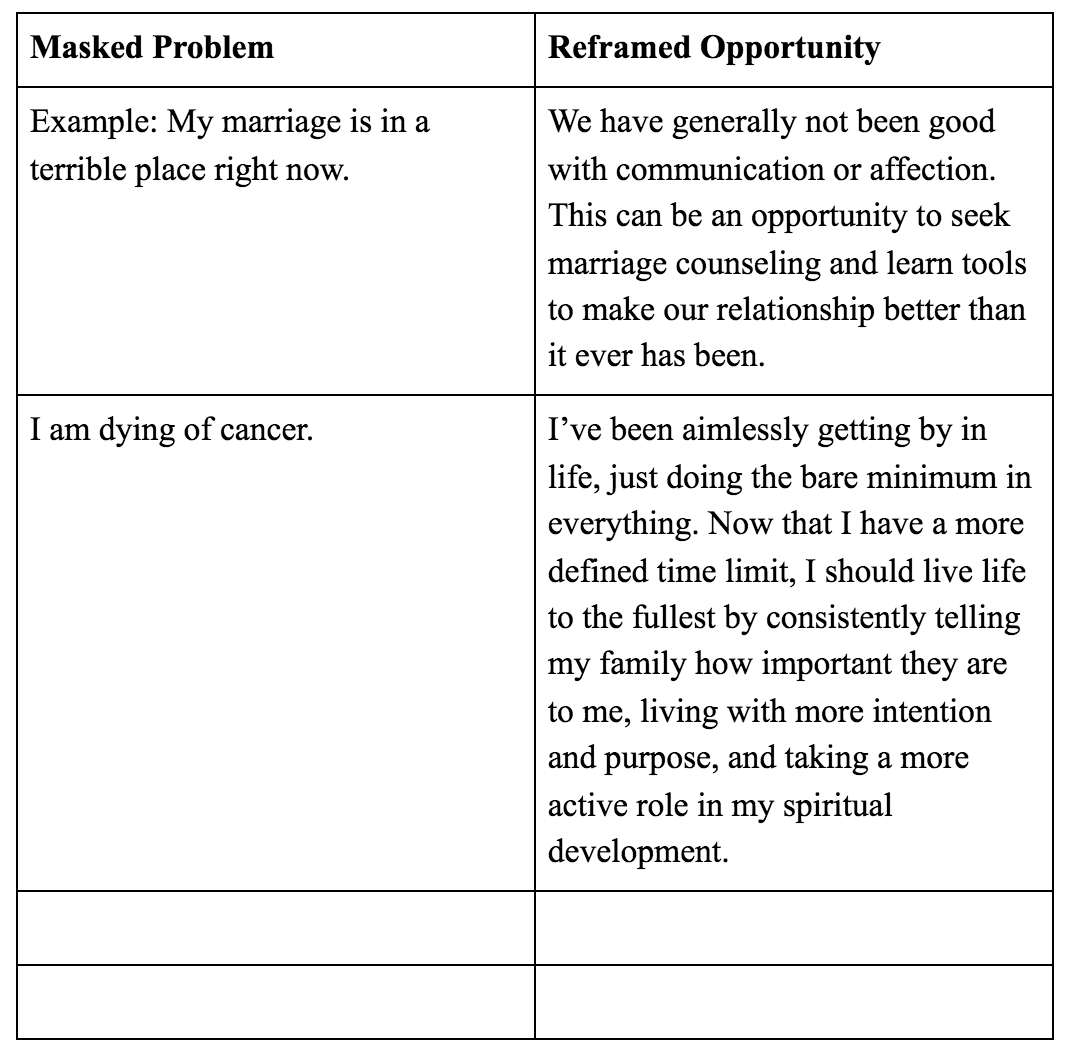Overcoming black-and-white thinking is no easy feat, but it can be done with self-compassion, commitment, and a lot of practice. You matter. Your feelings matter and your future matters. Allah put you on this earth for good reason and does not want you to end your life. He wants you to stay and find your way back to Him when it’s the right time.
If you have had this type of thinking all your life, then understand it cannot be undone with the flick of a switch. Looking at the world in black-and-white can not only deeply embed itself in your way of thinking, but in how your body responds to the environment around you as well. Some days your physical and mental urges to get caught up in the fight, flight, or freeze response will be stronger than others, and that is ok. The more you practice riding out those emotional waves, the easier it will be to tame them. Over time, you will notice that the black-and-white thinking still exists but the feelings will be less intense, less frequent, and less impactful.
Building Distress Tolerance
Distress tolerance is the ability to experience stress without being completely overcome by it and is a great way to start practicing coping with black-and-white thinking. It involves being able to take a step back, pausing, and then acting. The pause can be a few moments or a few days, but it’s enough time to allow you to recenter yourself. Maintaining calm doesn’t mean suppressing your feelings or pretending that a problem doesn’t exist; it means that you are stressed, but that you feel in control of yourself—instead of your emotions controlling you.
The Messenger of Allah ﷺ said: “(Real) Patience is at the first stroke of the calamity.”[6]
The first step in building distress tolerance is to know what stress feels like in your body. Humans experience emotional overwhelm in different ways, but individuals tend to experience similar symptoms within themselves in distressing situations. The next time you feel distressed, pay attention to your body and reflect on where you feel tension or pain. Notice if you have:
A racing heart
Labored breathing
Feelings of wanting to yell
Feelings of wanting to throw something
Sweating
Clenched fists
Tension in other parts of the body, like one’s neck or back
A sense of hastiness and wanting to take immediate action
Heat on your face, chest, or other parts of your body
Feeling like your body is shutting down
Symptoms are signs our bodies manifest
before we take action. The unrest, although uncomfortable, is actually a blessing in that it gives our bodies a signal and the ability to recognize that we have an opportunity to decide what happens next. Taking a pause in between the feeling and the action is the space where you can regain control of your body and thoughts and decide how to proceed.
[7] This is also the space where black-and-white thinking can be modified. Those who succumb to black-and-white thinking usually do it here, sometimes making snap decisions that end relationships and have catastrophic effects on opportunities and achievements. Some keywords to listen for in your mind during this time are: Always, never, and hate.“I hate my life:
“You are never there for me”
“I always fail.”
[8]
Practicing the pause in between stimulus (what is happening) and response (how you act) is where all your power lies to modify your black-and-white thinking and change the course of your future.
[9] You can decide if you want to act based on temporary emotions and feelings or if you want to act in accordance with healthy logic, your values, and what is in your long-term best interests. During this pause, try some of these effective exercises from the Dialectical Behavior Therapy (DBT) model to make better choices:According to Dialectical Behavior Therapy (DBT), we have 4 options when facing a calamity or hardship:
[10]
- Stay Miserable
- Solve the problem
- Change your perception of the problem
- Radically accept the problem
Staying Miserable
The first option is to stay miserable, a common path that many people take without even realizing it. The reason so many people take this path is because they think that not taking action is a way to avoid having to make a decision; but, in fact, not making a decision is a decision.
Let’s take staying in an extremely unhappy marriage, for example. Staying silent about one’s feelings, participating in futile fighting, and not getting marriage counseling are all choices. Avoiding meaningful action to change is, in effect, a decision to stay unhappy. Being miserable is probably the easiest of the four options but it still takes a lot of time and effort to maintain this unhealthy state.
When people realize that being miserable is a choice, the first instinct is to think, “Well, I don’t want to be miserable on purpose!” But they often continue to feel stuck because they don’t know what to do next or how to change. This is ok as awareness is the first step to change.
Solving the Problem
Behind every black-and-white thought there is usually a larger, big-picture issue at hand. Solving the problem is not always an option in cases involving trauma and calamity, but when possible it’s best to try solve the problem directly. Let’s look at a few examples:
If you are so upset at your parents for never letting you leave the house that you want to self-harm, the immediate issue is that you want to hurt yourself, but the big-picture issue is that there are significant communication, trust, and relational issues with your parents.
If you are so stressed out at work or school that you just want your life to end, the immediate issue is wanting to die but the big-picture issue is how you are relating to and coping with the demands in your life.
Although you may be faced with uncomfortable circumstances, addressing the problem at the root is the best way to reduce difficult emotions in the long term. An excellent way to solve a problem is to turn it into an action item and then create a basic pros and cons list associated with that idea. Writing out the pros and cons will help organize your thoughts, get more clarity on the situation, and ideally build insight into the best way to move forward. In the first example, the teen’s action item may be to ask her parents to go to family therapy or to speak with her guidance counselor about getting help. In the second example, one action item may be to consider changing from a full-time work/school schedule to part-time.
If you would like to take your pros and cons list one step further, you can use the Motivational Interviewing technique below.
[11] This technique is a more advanced pros and cons list that will help you think in a multidimensional way, whereas the traditional chart is simpler. The decision matrix looks like this:
The quicker you are able to complete the pros and cons list and act on it with due diligence, the better. The Prophet Muhammad ﷺ encouraged us to perform a prayer called istikhaara when making a decision. This prayer will help affirm your decision or deter you from it as Allah knows variables affecting your issue that you may not be aware of. It can also provide a sense of calmness in knowing that you have consulted with Your Creator, who knows you and your life better than anyone. Please see the end of this chapter for details about the istikhaara prayer.
Changing Perception of the Problem
If you can’t change your problem, then the next best thing is to change how you view it. Perhaps the problem is not as bad as you originally thought? Or maybe it’s not a problem, but could represent an opportunity? Perhaps you have more control over the problem than you think, or you play a bigger role in the problem than you think? After all most positive changes in life start out as something difficult.
Looking at the silver lining, making excuses for people, and deriving positive meaning from adversity are key ways of looking at the situation differently. Let’s take the example of someone who is suffering from a serious long-term illness. If you have ever met someone with a chronic disease, you know that there can be many setbacks at various points in their medical journey. A person who is overcome with emotion and gives into black-and-white thinking might say:
“Everyone in this hospital in incompetent.”
“There is no hope for me!”
“If I have this much pain, I might as well just be dead.”
The same person who pauses and tries to reframe their pain might say:
“I’m blessed to be able to get treatment for this illness even though it’s not perfect.”
“I’m scared and I don’t know how this disease will play out but I trust that Allah is the Best of Planners and everything good in my past, present, and future comes from Him.”
“To Allah we belong, to Allah we must all return—when it’s my time, Allah will take me. My pain now will alleviate my pain when my time here ends.”
The circumstances are identical, but reframing the problem completely changes the outlook of the person experiencing the difficulty. When you reframe a problem you are taking ownership of how the problem is presented to you which, in turn, gives you power. You are exemplifying that, while you may not have control over your circumstances, you do have control over how you view them, which is more important.
A good example of changing one’s views about a problem can be seen in the words of Ibn Taymiyyah, a well-known 13th-century Muslim scholar:
What can my enemies do to me! My garden and my paradise are in my breast wherever I go and they are with me. If my enemies kill me, I become a martyr and if they banish me from my country, I go abroad as a tourist, and by imprisoning me, they allow me to have solitude (so that I can worship Allah).[12]
For the average person, these circumstances may be very traumatic and terrible, but Sheikh Ibn Taymiyyah, may Allah have mercy on him, found a way to genuinely look at these circumstances in the best light so they had no power over him whatsoever.
Another way one can change one’s perspective on a problem is to imagine how the situation could be worse. Sheryl Sandberg, in her famous University of California at Berkeley 2016 commencement speech, talked about how this technique helped her with the immense grief she experienced when her husband suddenly died of complications due to a heart condition:
One day my friend Adam Grant, a psychologist, suggested that I think about how much worse things could be. This was completely counterintuitive; it seemed like the way to recover was to try to find positive thoughts. “Worse?” I said. “Are you kidding me? How could things be worse?” His answer cut straight through me: “Dave could have had that same cardiac arrhythmia while he was driving your children.” Wow. The moment he said it, I was overwhelmingly grateful that the rest of my family was alive and healthy. That gratitude overtook some of the grief.[13]
When you feel like you have hit rock bottom, it seems that there is nowhere else to go; however, rock bottom is relative. When you imagine that your difficult situation could be worse, you can gain perspective and gratitude that it may not be bad as it could be. Originally, Sandberg thought that the worst thing that could happen to her was her husband dying; however, when she realized that her children could have died as well if they had been riding in the car with him, then she had a big shift in how she viewed the situation. This does not take away from the legitimacy of the pain you are experiencing; however, it helps to shift some of the focus away from everything that has gone wrong back to the things that haven’t gone wrong.
Radical Acceptance
A final option is radical acceptance. Radical acceptance involves completely accepting in one’s mind and body the situation at hand so there is no longer any bitterness in the heart.
[14] Radical acceptance is not giving in or giving up. It’s also not complacency with matters that can be changed or should be changed. Domestic violence, for example, is not something radical acceptance would be appropriate for, whereas the death of a child would be. In the case of domestic violence, a person has options even if one doesn’t feel like pursuing them, whereas nothing can really change the death of a loved one.Radical acceptance also doesn’t mean accepting the stressor itself; rather, it means that you have accepted that this is the decree of Allah. Let’s take terminal cancer, for example. Radical acceptance doesn’t mean that you are ok with cancer or that you will not take steps to fight cancer, but it means that you accept this is a trial that you have to face. Radical acceptance is coming to peaceful terms that you might have cancer for a long time or may even die from cancer. In accepting the trial, you are not living in denial, but acknowledging the truth of your circumstances with no ill feelings in your heart or soul. Radical acceptance is riding the wave instead of fighting it.
Radical acceptance in Islam is eloquently expressed in this hadith:
The Messenger of Allah ﷺ said, “How wonderful is the case of a believer; there is good for him in everything and this applies only to a believer. If prosperity attends him, he expresses gratitude to Allah and that is good for him; and if adversity befalls him, he endures it patiently and that is better for him.”[15]
There is no easy way to achieve radical acceptance. This psychological concept is probably one of the most difficult achievements in one’s journey with trauma. Many people can accept bad things that happen to them, but not without bitterness or despair. Radical acceptance takes a lot of reflection, talking through, and faith. For some individuals it may also take working with a professional, sometimes for many years, to get to this place of acceptance; but it is possible.
Radical acceptance is the antithesis of black-and-white thinking. It’s being able to tolerate and accept something undesirable but still have hope, peace, and optimism. Instead of thinking, “I’m ill and there is no point in living,” it’s thinking, “I’m ill and in pain, but I have more to offer the world.” Instead of saying, “I’m in so much misery right now I should end my life,” it’s saying “I’m in so much despair, but I will hang on and make the most of my situation.”
Black-and-white thinking does not allow us to see the good and bad at the same time, while integration involves accepting the whole picture and being able to tolerate the good and bad simultaneously. Integration is being upset with others without ending relationships, being upset with oneself without resorting to self-harm, and even having extremely difficult life circumstances while still believing in Allah.
Self-Soothing Coping Skills
Pausing before falling into black-and-white thinking, changing your perspective on the problem, and radical acceptance are not easy tasks but can be made easier by practicing self-soothing activities at the same time. These types of activities also help take the sharp edge off of difficult feelings of anxiety, agitation, anger, and depression. The next time you are experiencing intense emotions, consider the following self-soothing activities to help you practice the pause longer.
Affirmations: Affirmations are brief and often powerful sayings you tell yourself to help shift your thoughts towards something positive. The nice thing about affirmations is that you don’t have to believe the thoughts (at least initially) to practice them. The more you use them, however, the more you begin to alter your thoughts and begin to believe them.
This is not what I would have chosen, but I’m at peace with it.
Hasbi Allaho wa naima Al Wakeel (Allah is sufficient for me and is the Best Trustee of affairs).
I don’t have control in this situation, but I have control over myself and that is enough.
I accept what has been ordained for me and I know Allah will bring something good from this.
I trust Allah and His Plan and His Wisdom.
Deep breathing: When you get upset, your breathing automatically becomes more rapid and shallow. This sends ongoing messages to your brain that you are upset and, in turn, your brain will continue to send back messages to the rest of your body that result in constricted breathing. Taking deep breaths will help counter this and make you feel more stable. Breathe in through your nose for 4 seconds, hold your breath for 4 seconds, and then exhale through your mouth like it is holding a straw for at least 6 seconds. Practice this 10 times or as long as you need to.

Tawakkul & Practicing Hope: Have you ever driven around in really thick fog and were taken aback that you could not see the road, the usual buildings, and everything else you typically observe on your commute? Everything looks like it is covered and you can not see past what is right in front of your car. Although it might be anxiety-provoking, you know with certainty that despite not being able to see anything, all those objects are still there. The same is for tawakkul (reliance on Allah). You may not readily see Allah in the fog of your distress but you can constantly remind and affirm to yourself that He is still there, loves you and wants what is best for you. Intentionally practicing and looking at situations with optimism can also remind you that although you are in very difficult circumstances now, relief will eventually come and that good things lie ahead.
For indeed, with hardship [will be] ease. Indeed, with hardship [will be] ease. (Quran, 94: 5-6)
Additionally, practicing hope and
tawakkul during times of ease will help them come to mind more quickly when in distress. Abu Zayd al-Balkhi, a pioneer of Islamic cognitive psychotherapy in the 9th century, indicates that similar to the healthy person who keeps medicine readily at hand in case an unexpected ailment occurs, the same should be done with thoughts. Healthy thoughts should be stored during a tranquil state so they can be easily accessible when emotional distress occurs.
[17]Replace thoughts with cognitive activities: If you are feeling consumed with your thoughts, put them to the side and distract yourself with other thought-based activities like doing a puzzle, learning a new task, or building something new. Distracting yourself in a healthy way can help you keep your mind off the problem until you calm down.
Replace thoughts with grounding physical activities: In psychosomatic literature, which focuses on how psychological ailments manifest themselves through the body, triggering thoughts that jump-start the fight or flight response can be minimized through positive physical touch and pressure.
[18] Simple physical activities may include wrapping yourself in a blanket (what Prophet Muhammad ﷺ did when distressed at first receiving revelation), lying flat on the floor (a recommended
sunnah for when angry), or placing your hand on your heart. These small gestures are very simple but can profoundly help you feel more safe, in control, and secure. 



 You have four options anytime you are facing a problem. Fill out the graph below with how life would be if you tried each option:
You have four options anytime you are facing a problem. Fill out the graph below with how life would be if you tried each option:
